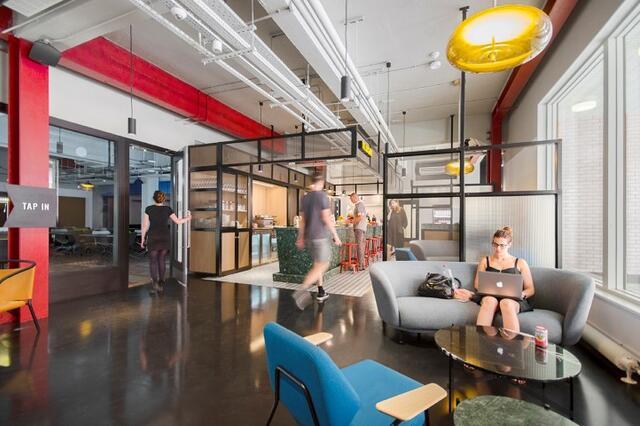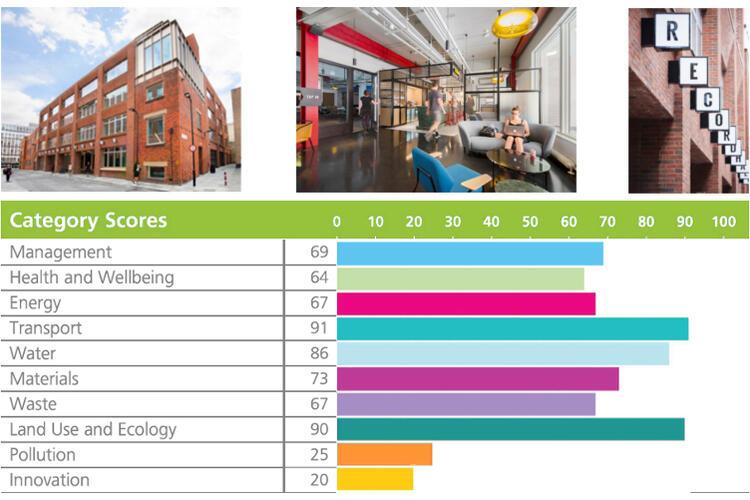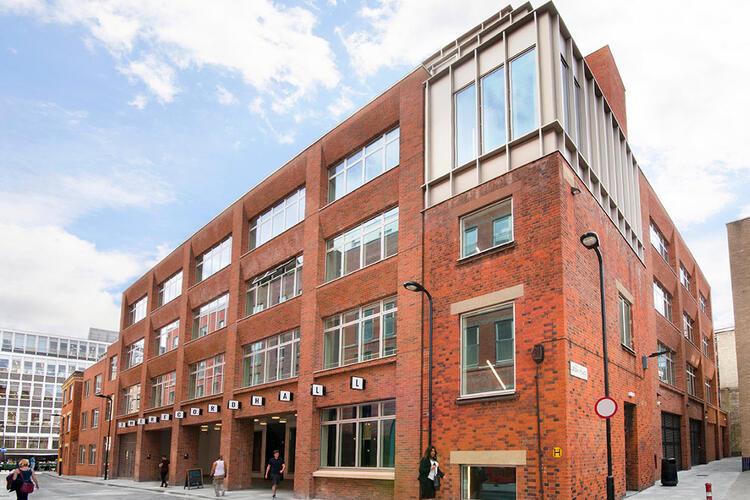Workspace’s Sustainable Refurbishment at The Record Hall
16 August 2017Workspace’s Sustainable Refurbishment at The Record Hall
16 August 2017During the refurbishment and redevelopment of The Record Hall, Workspace made BREEAM Excellent a priority from the outset, exceeding planning requirements. The whole project team worked collaboratively to successfully embed sustainability into every aspect of the scheme and create a location of choice for occupiers.
Key Facts
- BREEAM EXCELLENT DESIGN STAGE
- ENERGY PERFORMANCE CERTIFICATE A FOR NEW SPACE AND B FOR THE REFURBISHMENT
- 279SQM OF GREEN ROOF SPACE
- 85SQM ARRAY OF SOLAR PHOTOVOLTAIC PANELS
Situation
Workspace owns properties across London and is home to new and growing companies. Sustainability is embedded throughout the business, and is increasingly embraced by Workspace customers, who want to ensure they are having a positive impact on the environment and wider community.
At The Record Hall, Workspace is transforming a former record depository to create 5,400m2 of modern office and studio space over six floors, with high-tech meeting rooms, a co-working lounge, a café and roof terraces offering views across the City. Located in the Hatton Garden Conservation Area, 14% of the scheme is designated for jewellery businesses, reflecting the area’s heritage as London's jewellery district.
The project involves refurbishing an existing four-storey office building and adding a two-storey roof extension. The team includes Karakusevic Carson Architects, building services engineers Max Fordham, main contractor HG Construction, cost consultant Stace and structural engineer Thornton Tomasetti, which also provides BREEAM assessor services. All have strong environmental credentials and have worked with Workspace on other BREEAM projects.
Actions
The Record Hall achieved BREEAM Excellent Design Stage, scoring particularly highly for transport, land use and ecology. The project team is now working towards Excellent for the Post Construction Stage (final). Design features and construction plans are outlined below.
Transport
- Cycle facilities exceed BREEAM requirements, with 51 secure indoor cycle spaces, 54 lockers, six showers and changing facilities.
- Travel Plan developed to encourage sustainable travel through information, facilities and incentives.
- Highest possible rating on Transport for London's Public Transport Accessibility Level (6b), with Farringdon, Chancery Lane, Holborn, City Thameslink and Blackfriars stations all within walking distance.
Land use and ecology
- Ecologist appointed at an early stage of design, reviewing ecological value and opportunities.
- 279m2 of green roof space added on two levels, with a 100% wildflower turf vegetation layer.
- Habitats and planting designed to support regional and national biodiversity action plans, including the London Biodiversity Action Plan e.g. Leontodon autumnalis, a plant specific to a rare UK beetle, Olibrus flavicornis.
- Contractor appointing a biodiversity champion, delivering training to the site team on how to protect ecology, and reporting ecology actions.
Health and wellbeing
- All lighting specified in line with best practice guidelines for visual performance and comfort (CIBSE Code for Lighting 2012 and Lighting Guides 6 and 7).
- Lighting zoned and controllable in office areas, so occupiers can easily adjust light levels.
- High frequency ballasts on all fluorescent lamps to reduce the risk of flickering.
- Blinds with side cords on windows, so occupiers can control shading.
- Improved air quality, with air intake designed to avoid key external pollution sources.
- Good thermal comfort levels in office areas, with all office areas actively cooled (CIBSE AM11).
- Temperature controls in each occupied space, so levels can be adjusted for different users’ needs.
- Reduced noise levels through insulation, outperforming BREEAM requirements of 50 dB LAeq in all internal areas.
Energy
- Zero carbon energy from 85m2 array of 230W solar photovoltaic panels, supplied by EvoEnergy, chosen based on compliance with the specification, trading record and costs.
- Low carbon energy from reversible air source heat pumps.
- Energy efficient lifts that operate in standby mode during off peak and idle times, with variable speed drive motors and electricity generated by the lift movement returned to the site.
- Extensive energy sub-metering, so the building team and occupiers can monitor and proactively manage energy use. Occupiers will be given logins to view their energy profiles directly.
- Energy efficient internal and external lighting throughout, in conjunction with daylight sensors and presence detection to further reduce consumption.
- Mix of mechanical ventilation with heat recovery and natural ventilation to reduce emissions.
Water
- Toilets with effective flush of three litres or less, achieving the maximum BREEAM credits.
- Taps fitted with two litres per min Eco spray outlet and showers not exceeding nine litres per minute.
- Water metering and leak detection, so the building team can monitor and proactively manage consumption.
- Proximity detection shut-off system in all toilet areas to prevent waste water from minor leaks by shutting off the supply when no one is there.
Materials
- At least 80% of timber certified sustainably sourced.
- At least 80% of key building elements responsibly sourced, as defined by the Green Guide to Specification, with A/A+ rated elements including plasterboard, steelwork and vinyl flooring.
- Masonry brickwork façade retained, reducing lifecycle emissions.
- Thermal insulation products with low embodied impact relative to their thermal properties, determined by the Green Guide to Specification, and responsibly sourced.
- Exposed building and landscape areas protected to minimise the frequency of use of replacement materials.
Waste
- Less than 6.5 tonnes or 12.9m3 of waste to be generated per 100m2 gross internal floor area – reducing waste through careful procurement (e.g. ordering precise quantities needed and purchasing plasterboard at 2.7m high to suit storey height) and use of prefabricated materials (e.g. precast brick faced panels).
- At least 90% of demolition waste and 75% of construction waste (by weight) to be diverted from landfill, with all waste sent to a registered sorting station.
- Onsite recycling facilities for occupiers in a central, dedicated space.
Management
- Commissioning in line with current best practice and included in main contract preliminaries.
- Green leases covering heating, cooling, lighting, sustainable travel, alterations and data sharing.
- Building User Guide to support occupiers in operating their areas efficiently.
- 43/50 Considerate Constructors Scheme score, reflecting care about appearance, community, environment, safety and workforce.
Financials
- £63,200 investment in the green roof.
- £1,200 for BREEAM certificates.
- Enhanced occupier appeal, contributing to rental income.
- Reduced construction costs by retaining building structure and façade.
- Energy cost savings for occupiers.
Benefits
Workspace
- Upgrading office space and adding 582m2 of café space and 279m2 of roof terraces.
- Extending the building’s useful life.
- Enhancing sustainability credentials, through BREEAM Excellent and an EPC score of B-26, up from C before the project.
- Preventing exposure to the Minimum Energy Efficiency Standards, which come into force in 2018.
Occupiers
- Modern space designed for employee wellbeing, including improved thermal comfort, air quality and lighting.
- Offices and studios that are efficient to operate, with cost savings through efficiency.
- Roof terraces for people and wildlife to enjoy, with a mix of decking and biodiverse green space.
- Facilities for cyclists to support active commuters.
- BREEAM Excellent rating and features support occupiers’ sustainability credentials.
- 65% estimated reduction in CO2 emissions in existing areas, compared to before the refurbishment.
- 17.5% reduction in Part L CO2 emissions through PV panels and 3.8 tonnes annual CO2 savings.
Challenges and Achievements
BESPOKE
How to achieve BREEAM Excellent in an unusual scheme?
The Record Hall is part refurbishment and part new build. It is also mixed use, providing office space, retail and light industrial units. As a result, no single BREEAM assessment was appropriate for the whole scheme. The BREEAM assessor provided the architectural drawings to BRE at an early stage, so that a bespoke assessment spreadsheet could be developed, with different weightings for each zone depending on whether it was refurbishment, new-build, office, retail or light industrial. The existing footprint of the building also meant that some credits were simply not feasible e.g. deep floorplates excluded credits for views out in some areas, even though a large proportion of the internal walls are glazed, maximising views. In addition, two small lightwells are being transformed into a full-height lightwell at the heart of the building, adding natural light and contributing to the natural ventilation strategy. To achieve BREEAM Excellent, the team therefore had to focus on achieving virtually every credit that was feasible.
TEAM
How to collaborate on BREEAM Excellent?
At the BREEAM pre-assessment meeting, the assessor presented the list of potential credits and outlined what would be required to achieve them. Workspace, Karakusevic Carson Architects, Max Fordham and Thornton Tomasetti demonstrated a positive, can-do attitude and agreed to target almost all potential credits. They then came together for monthly meetings throughout the design stage to check that everything was on track for each credit. Camden Council planners were also involved in early team meetings as the scheme was going through changes and they wanted to be confident that the BREEAM Very Good planning requirement would be achieved. Importantly, when the construction stage started, the team engaged HG Construction and Stace on the BREEAM requirements and included these in the preliminary documents, so they were incorporated from the outset.
*Please note that the information on this page was supplied by the BBP Member and the BBP assumes no responsibility or liability for any errors or omissions in the content


